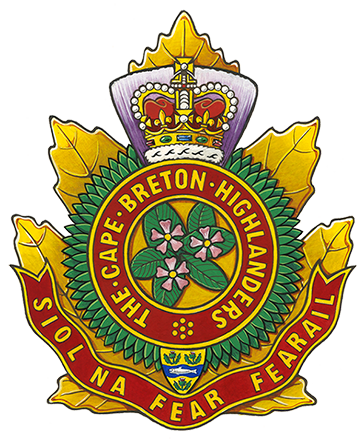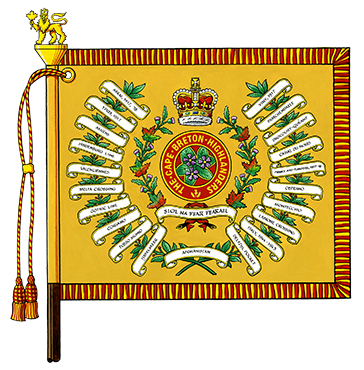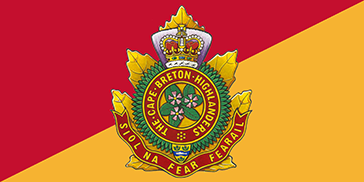The Cape Breton Highlanders
The official lineage of The Cape Breton Highlanders infantry regiment.

Colonel-in-Chief: Vacant
Badge
Description
A maple leaf Or charged with a thistle head proper bearing a bezant surcharged with mayflowers leaved proper and encircled by an annulus Gules edged and inscribed THE CAPE BRETON HIGHLANDERS in letters Or ensigned by the Royal Crown proper and resting on the Arms of Nova Scotia (1868) above a scroll Gules edged and inscribed with the Motto in letters Or;
Symbolism
The design includes elements taken from the badges of the predecessor units of The Cape Breton Highlanders. The mayflower is the provincial flower of Nova Scotia, where the regiment is located. The arms of the province are those in use at the time of the badge’s creation. The thistle is the emblematic flower of Scotland, while the maple leaf represents Canada. The Royal Crown indicates service to the Sovereign.
Motto
SIOL NA FEAR FEARAIL (Breed of manly men)
March
“Highland Laddies”
Alliance
British Army
The Mercian Regiment
Regimental colour

Camp flag

Battle honours
The First World War
YPRES, 1917; ARRAS, 1917, '18; Vimy, 1917; Scarpe, 1918; Passchendaele; AMIENS; Drocourt-Quéant; HINDENBURG LINE; Canal du Nord; VALENCIENNES; SAMBRE; FRANCE AND FLANDERS, 1915-18.
The Second World War
LIRI VALLEY; Melfa Crossing; Ceprano; GOTHIC LINE; Montecchio; CORIANO; LAMONE CROSSING; Fosso Munio; Conventello-Comacchio; ITALY, 1944-1945; Ijsselmeer; Delfzijl Pocket; NORTH-WEST EUROPE, 1945.
South-West Asia
AFGHANISTAN
Lineage
The Cape Breton Highlanders originated in Baddeck, Nova Scotia on 13 October 1871, when the 'Victoria Provisional Battalion of Infantry' was authorized to be formed.Footnote 1 It was redesignated: 'Victoria "Highland" Provisional Battalion of Infantry' on 12 December 1879;Footnote 2 'Victoria Provisional Battalion of Infantry "Argyll Highlanders"' on 9 April 1880;Footnote 3 '94th "Victoria" Battalion of Infantry, "Argyll Highlanders"' on 12 June 1885;Footnote 4 '94th Victoria Regiment "Argyll Highlanders"' on 8 May 1900;Footnote 5 'The Cape Breton Highlanders' on 29 March 1920;Footnote 6 '2nd (Reserve) Battalion, The Cape Breton Highlanders' on 7 November 1940;Footnote 7 'The Cape Breton Highlanders' on 15 February 1946;Footnote 8 and the '2nd Battalion' of 'The Nova Scotia Highlanders' on 15 September 1954.Footnote 9 On 9 December 2010 it was organized as a separate regiment and redesignated ‘The Cape Breton Highlanders’.Footnote 10
Notes:
Upon redesignation as The Cape Breton Highlanders on 29 March 1920 (see above), it was organized as a two battalion regiment with the 1st Battalion (85th Battalion, CEF) on the Non Permanent Active Militia order of battle and the 2nd Battalion (185th Battalion, CEF) on the Reserve order of battle. The reserve unit was disbanded on 14 December 1936 (GO 3/37).
The Cape Breton Highlanders were disbanded for the purpose of reorganization on 1 November 1920 and reorganized the same day (GO 253/20). This change was administrative and does not affect the lineage of the regiment.
On 21 June 1955, the 1st Battalion was redesignated '1st Battalion, The Nova Scotia Highlanders (North)' and the 2nd Battalion the '2nd Battalion, The Nova Scotia Highlanders (Cape Breton)' (CAO 110-3, Pt 'B' Supp Issue No. 446/55).
On 12 August 1977, all generic titles in the Canadian Forces, such as 'battalion', were made bilingual (Memorandum, DGBB (Director General Bilingualism and Biculturalism), 1901-1/1211-7-4, 12 Aug 77).
Perpetuations
'85th' and '185th "Overseas" Battalion(s), CEF'
Headquarters Location
Sydney, Nova Scotia
Operational history
The First World War
Details of the 94th Victoria Regiment "Argyll Highlanders" were placed on active service on 6 August 1914 for local protection duties.Footnote 11
The 85th Battalion, which was authorized on 10 July 1915 as the '85th "Overseas" Battalion, CEF',Footnote 12 embarked for Great Britain on 12 October 1916.Footnote 13 It disembarked in France on 10 February 1917, where it fought as part of the 12th Infantry Brigade, 4th Canadian Division in France and Flanders until the end of the war.Footnote 14 The battalion was disbanded on 15 September 1920.Footnote 15
The 185th Battalion, which was authorized on 15 July 1916 as the '185th "Overseas" Battalion', CEF,Footnote 16 embarked for Great Britain on 12 October 1916.Footnote 17 It provided reinforcements for the Canadian Corps in the field until 15 February 1918, when its personnel were absorbed by the '17th Reserve Battalion, CEF'.Footnote 18 The battalion was disbanded on 29 November 1918.Footnote 19
The Second World War
Details of The Cape Breton Highlanders were called out on service on 26 August 1939 and then placed on active service on 1 September 1939, under the designation 'The Cape Breton Highlanders, CASF (Details)', for local protection duties.Footnote 20 The details called out on active service were disbanded on 31 December 1940.Footnote 21
The regiment subsequently mobilized the '1st Battalion, The Cape Breton Highlanders, CASF' for active service on 1 January 1941.Footnote 22 It embarked for Great Britain on 10 November 1941.Footnote 23 It landed in Italy on 10 November 1943 as part of the 11th Infantry Brigade, 5th Canadian Armoured Division.Footnote 24 The battalion moved to North-West Europe from 20 to 26 February 1945, where it continued to fight until the end of the war.Footnote 25 The overseas battalion was disbanded on 15 February 1946.Footnote 26
South-West Asia
From 2002 to 2014, the Cape Breton Highlanders reinforced various CAF units deployed to Afghanistan.Footnote 27
Page details
- Date modified: